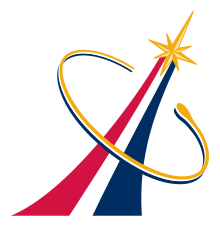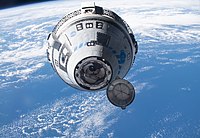
Back برنامج الطاقم التجاري Arabic Commercial-Crew-Programm German Programa de Tripulación Comercial Spanish Erameeskondade programm Estonian Commercial Crew Program Finnish Programme d'équipage commercial French התוכנית המאוישת המסחרית HE Program Commercial Crew ID Commercial Crew Program Italian 商業乗員輸送計画 Japanese
 Logo since 2014 | |
| Program overview | |
|---|---|
| Country | United States |
| Organization | |
| Purpose | ISS crew transport |
| Status | Ongoing |
| Program history | |
| Duration | 2011–present |
| First flight |
|
| Successes | 7 |
| Launch site(s) | |
| Vehicle information | |
| Crewed vehicle(s) | |
| Launch vehicle(s) | |
| Part of a series on the |
| United States space program |
|---|
  |
The Commercial Crew Program (CCP) provides commercially operated crew transportation service to and from the International Space Station (ISS) under contract to NASA, conducting crew rotations between the expeditions of the International Space Station program. American space manufacturer SpaceX began providing service in 2020, using the Crew Dragon spacecraft, and NASA plans to add Boeing when its Boeing Starliner spacecraft becomes operational no earlier than 2026.[1] NASA has contracted for six operational missions from Boeing and fourteen from SpaceX, ensuring sufficient support for ISS through 2030.[2]
The spacecraft are owned and operated by the vendor, and crew transportation is provided to NASA as a commercial service. Each mission sends up to four astronauts to the ISS. Operational flights occur approximately once every six months for missions that last for approximately six months. A spacecraft remains docked to the ISS during its mission, and missions usually overlap by at least a few days. Between the retirement of the Space Shuttle in 2011 and the first operational CCP mission in 2020, NASA relied on the Soyuz program to transport its astronauts to the ISS.
A Crew Dragon spacecraft is launched to space atop a Falcon 9 Block 5 launch vehicle and the capsule returns to Earth via splashdown in the ocean near Florida. The program's first operational mission, SpaceX Crew-1, launched on 16 November 2020. Boeing Starliner spacecraft will participate after its final test flight, launched atop an Atlas V N22 launch vehicle. Instead of a splashdown, a Starliner capsule will return on land with airbags at one of four designated sites in the western United States.
Development of the Commercial Crew Program began in 2011 as NASA shifted from internal development of crewed vehicles to perform ISS crew rotation to commercial industry development of transport to the ISS. A series of open competitions over the following two years saw successful bids from Boeing, Blue Origin, Sierra Nevada, and SpaceX to develop proposals for ISS crew transport vehicles. In 2014, NASA awarded separate fixed-price contracts to Boeing and SpaceX to develop their respective systems and to fly astronauts to the ISS. Each contract required four successful demonstrations to achieve human rating for the system: pad abort, uncrewed orbital test, launch abort, and crewed orbital test. Operational missions were initially planned to begin in 2017, with missions alternating between the two providers. Delays required NASA to purchase additional seats on Soyuz spacecraft up to Soyuz MS-17 until Crew Dragon missions commenced in 2020. Crew Dragon continues to handle all missions until Starliner becomes operational no earlier than 2026.[1]
- ^ a b Cite error: The named reference
NASA20241015was invoked but never defined (see the help page). - ^ Foust, Jeff (1 September 2022). ""NASA and SpaceX finalize extension of commercial crew contract"". spacenews.com. Retrieved 1 October 2022.

